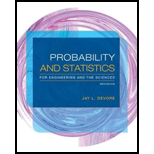
Concept explainers
Each headlight on an automobile undergoing an annual vehicle inspection can be focused either too high (H), too low (L), or properly (N). Checking the two headlights simultaneously (and not distinguishing between left and right) results in the six possible outcomes HH, LL, NN, HL, HN, and LN. If the probabilities (population proportions) for the single headlight focus direction are P(H) = θ1, P(L) = θ2, and P(N) = 1 − θ1 − θ2 and the two headlights are focused independently of one another, the probabilities of the six outcomes for a randomly selected car are the following:
Use the accompanying data to test the null hypothesis
where the πi,( θ1, θ2)s are given previously.
| Outcome | HH | LL | NN | HL | HN | LN |
| Frequency | 49 | 26 | 14 | 20 | 53 | 38 |
[Hint: Write the likelihood as a
Test the null hypothesis that
Answer to Problem 19E
There is sufficient evidence to reject the null hypothesis that
Explanation of Solution
Given info:
Assume that a vehicle inspection is conducted to check whether the headlamp is too high H or too low L and proper N. Samples of two vehicle headlamp was checked simultaneously.
Also, the single probability for each headlamp focus is given below:
The six possible outcomes are HH, LL, NN, HL, LN, HN and the six probabilities are:
Calculation:
There are three cell counts in the given data. Hence, there would be three cell proportions and it is given below:
The likelihood estimate of
Taking ln yields,
Maximizing the equation with respect to
Equating to zero yields,
Also,
Maximizing the equation with respect to
The value of
Subtracting the two equations,
Substitute
Similarly,
The estimates
Substitute the observed values in each of the estimates
From these values the expected proportions are calculated as follows:
Substitute
Substitute
Testing the hypothesis:
Null hypothesis:
Alternative hypothesis:
Expected frequency:
The expected frequency for each group is calculated as follows,
Where,
n is the total number of observed frequency.
The expected frequency is calculated as follows:
| Category | Observed frequency | Expected frequency |
| HH | 49 | |
| LL | 26 | |
| NN | 14 | |
| HL | 20 | |
| HN | 53 | |
| LN | 38 | |
| Total | 200 |
Test statistic:
Where,
The table shows the calculation for chi-square test statistic:
| Category |
Observed |
Expected | |
| HH | 49 | 36.6 | 4.201 |
| LL | 26 | 15.2 | 7.674 |
| NN | 14 | 17.8 | 0.811 |
| HL | 20 | 47.0 | 15.511 |
| HN | 53 | 50.8 | 0.095 |
| LN | 38 | 32.8 | 0.824 |
| Total | 29.1 |
Thus, the test statistic is 29.1.
Degrees of freedom:
If there are k categories given, then the degrees of freedom would be
Here, there are six categories, the degrees of freedom is,
Critical value:
Use the Table A.7 to find the chi-square critical values.
Locate 5 under the column of v.
In the column of
The value intersecting these two numbers will give the critical value corresponding to
Thus, the critical value is
Decision rule:
The null hypothesis would be rejected if the P-value is lesser than or equal to the level of significance
Conclusion:
The test statistic value is 29.1 and the critical value is 16.748.
The test statistic value is greater than the critical value.
Hence, the P-value would be lesser than the level of significance.
That is,
Hence, the null hypothesis is rejected.
Thus, there is no sufficient evidence to conclude that the six observed proportions are equal to the expected proportion.
Want to see more full solutions like this?
Chapter 14 Solutions
Probability and Statistics for Engineering and the Sciences
- Algebra & Trigonometry with Analytic GeometryAlgebraISBN:9781133382119Author:SwokowskiPublisher:Cengage
 College AlgebraAlgebraISBN:9781305115545Author:James Stewart, Lothar Redlin, Saleem WatsonPublisher:Cengage Learning
College AlgebraAlgebraISBN:9781305115545Author:James Stewart, Lothar Redlin, Saleem WatsonPublisher:Cengage Learning

